Eugene Polley is not the most popular man on the planet. But perhaps he should be.
He left a legacy of leisure that billions of people lean upon each and every day.
Polley, a self-taught mechanical engineer from Chicago, invented the television remote control in 1955.
He envisioned a future in which we never had to leave the couch or twitch any muscle more than a finger.
MEET THE AMERICAN WHO SAVED THE CHAMPAGNE INDUSTRY: MISSOURI SCIENTIST CHARLES VALENTINE RILEY
Eugene Polley changed our lives for the easier.
Polley worked for Zenith Electronics for 47 years, climbing his way up from stock boy to groundbreaking inventor. He developed 18 different patents.
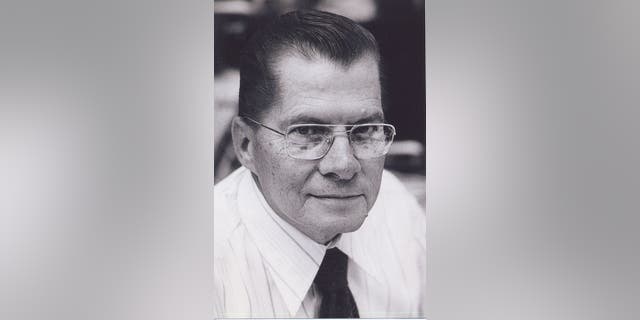
Eugene Polley invented the first wireless TV remote control, the Zenith Flash-Matic, in 1955. It operated the boob tube with beams of light.
(Zenith Electronics)
His most consequential innovation, the first wireless TV remote control, was called the Flash-Matic. The few previous control devices were hard-wired to the television.
It looked like a science-fiction ray gun. It operated the boob tube with beams of light.
Polley’s Flash-Matic replaced the only known remote control TV technology at the time, the 8-year-old child.
This primitive and often unreliable form of human labor had begrudgingly walked back and forth to change channels on demand for adults and older siblings ever since the advent of television.
The Flash-Matic looked like a science-fiction ray gun. It operated the boob tube with beams of light.
“When kids changed the channel, they usually had to adjust the rabbit ears, too,” joked Zenith senior vice president and company historian John Taylor.
Like millions of Americans over age 50, Taylor logged countless unpaid hours of his youth clicking the dials on the family TV set.
The Flash-Matic offered a “startling new kind of television,” Zenith announced in a press release dated June 13, 1955.
SHERIFF MARK LAMB CALLS OUT ‘ATTACK ON TRADITIONAL VALUES’ IN AMERICA, HAS A FIX FOR THAT
The new product, Zenith stated, “uses a flash beam from a small pistol-shaped gadget to turn the set on or off change channels or cut out the sound of long-winded commercials.”
The Zenith announcement continued, “The magic ray (which is harmless to humans) does all the work. No dangling wires or connected cords are needed.”

The Zenith Flash-Matic, the first wireless television remote control, was introduced in 1955 and designed to look like a space-age ray gun.
(Gene Polley Jr.)
The world has never been the same.
“For many people, it’s the most-used object in everyday life,” the inventor, at that point long retired, told Sports Illustrated in 1999.
“It gets more use than the flush toilet.”
The descendants of his innovation are everywhere today. Most people have several TV remotes at home, with more at the office or the job site — and maybe one in an SUV.
BARBARA WALTERS LEFT BEHIND MESSAGES SBOUT HER ‘SENSE OF ISOLATION’ AS A CHILD — AND WHAT DROVE HER SUCCESS
Despite the ubiquity of the TV remote, the name of its inventor was almost lost to history.
Elvis Presley is more famous than Eugene Polley simply because he could swivel his hips.
Yet who impacts our lives more each day? Eugene Polley had to fight for his legacy after credit for inventing the TV remote first went to a rival engineer.
Bootlegger’s son
Eugene Joseph Polley was born in Chicago to Anthony and Veronica (Wachowski) on Nov. 29, 1915.
Both were of Polish descent. Veronica came from a well-off family but married a “black sheep” husband, the inventor’s son, Gene Polley Jr., told Fox News Digital.
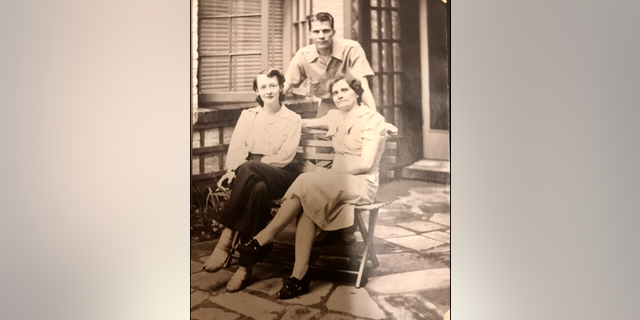
Television remote control inventor Eugene Polley with his wife, Blanche (Wiley), left, and his mother, Veronica.
(Courtesy Gene Polley Jr.)
Anthony Polley “was a bootlegger” with a colorful history, Gene Jr. said.
“He ended up running for governor of Illinois.” He even boasted connections at the White House. “My dad got to meet the president when he was a young boy,” Gene Jr. added.
“My father wore hand-me-down clothes. Nobody would pitch in to help him with an education.” — Gene Polley Jr.
Despite the father’s ambition and connections, the Polley family possessed limited financial means.
“My father wore hand-me-down clothes,” Polley Jr. said. “Nobody would pitch in to help him with an education.”
The future inventor tried two years of college but dropped out due to a lack of finances.
MEET THE AMERICAN WHO CREATED THE NATION’S FIRST SPORTS BAR IN ST. LOUIS: WORLD WAR II VETERAN JIMMY PALERMO
He ended up with a job as a stock clerk in 1935 at what was then called Zenith Radio Company.
Now a division of LG electronics, Zenith was founded in 1921 in Chicago by a team of partners that included World War I U.S. Navy veteran Eugene F. McDonald.
He was known around the company as the commander.
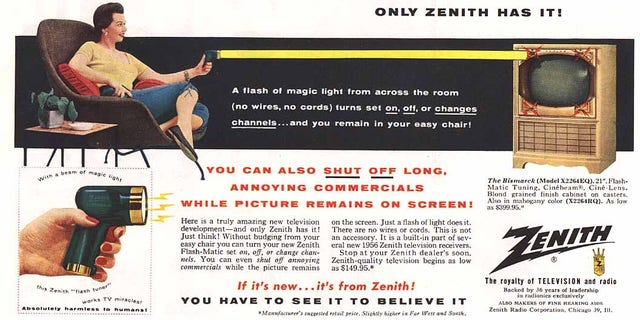
Zenith introduced Polley’s Flash-Matic television remote control in 1955.
(Zenith Electronics)
Polley’s work ethic, organizational skills and natural mechanical ability caught the attention of the commander.
When the United States entered World War II in the 1940s, Polley was part of the Zenith engineering teams who were working on major weapons programs for Uncle Sam.
Polley helped develop radar, night vision and proximity fuses, which use radio waves to ignite ordnance at a set distance from its target.
Polley in World War II helped develop radar, night vision and proximity fuses, which used radio waves to ignite ordnance.
American consumer culture exploded after the war — and Zenith was at the forefront of the rapidly growing television market.
‘DANCING WITH THE STARS’ PRO WITNEY CARSON REVEALS THE SEX OF SECOND BABY WITH HUSBAND CARSON MCALLISTER
Commander McDonald, however, was among those annoyed by the bane of broadcast television: commercial interruptions. He ordered the creation of the remote control so that he had a way to mute the sound during the breaks in programming. The commander, of course, saw the profit potential, too.
Polley designed a system with a television that contained four photo cells, one in each corner of the console. Users could change both picture and sound by pointing the Flash-Matic at the proper photo cell embedded in the TV.
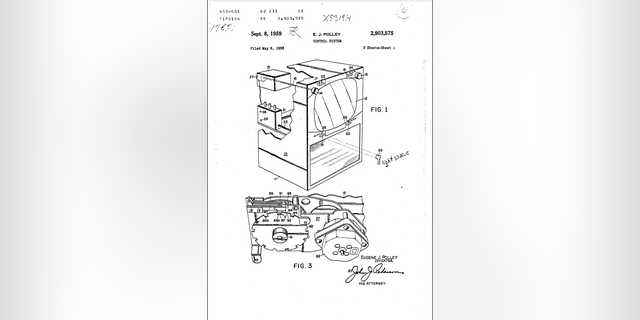
Eugene Polley invented remote control TV for Zenith in 1955. He filed for the patent on behalf of the company that year and received it in 1959. It included a system of photo cells to receive a signal within the console.
(US Patent and Trademark Office)
“He drove to Commander McDonald’s house and installed it for him,” said Polley Jr.
“Within a week, the commander said he wanted it in production. It sold like hot cakes — they couldn’t keep up with demand.”
Battle for his legacy
“Commander McDonald loved the concepts proven by Polley’s Flash-Matic,” Zenith states in a company history. But he quickly “directed his engineers to explore other technologies for the next generation.”
Polley’s remote control had its limitations. Most notably, its use of light beams meant ambient light — such as sunlight moving through a home — could disrupt the television.
Just a year after the Flash-Matic hit the market, Zenith introduced a new product, the Space Command, designed by engineer and prolific inventor Dr. Robert Adler. It was a radical departure in technology, using ultrasound instead of light to control the tube.

Zenith came out with its next-generation TV remote, dubbed Space Command, in 1956. It was developed by Dr. Robert Adler. It was the first “clicker”-style remote, replacing remote-control technology created by Zenith engineer Eugene Polley.
(Zenith Electronics)
The Space Command “was built around aluminum rods that were light in weight and, when struck at one end, emitted distinctive high-frequency sounds … They were very carefully cut to lengths that would generate four slightly different frequencies.”
Different frequencies controlled different functions: on/off, channels and sound.
It was the first “clicker” remote — the click caused when a small hammer struck the end of one of the aluminum rods.
Adler’s Space Command quickly surpassed Polley’s Flash-Matic in sales and popularity.
And Adler soon replaced Polley in the eyes of the industry as the inventor of the TV remote.
Dr. Robert Adler soon replaced Eugene Polley in the eyes of the industry as the inventor of the TV remote.
The National Inventors Hall of Fame actually calls Adler the inventor of the first “practical” TV remote control. Polley is not in the inventors’ club.
Polley’s pioneering work in remote TV technology was being swept aside.
“Adler had a reputation for taking credit for collaborative work that was done by other engineers at Zenith,” claims Polley Jr. “It just annoyed the hell out of my father,” he added.
ON THIS DAY IN HISTORY, DEC. 28, 1958, COLTS BEAT GIANTS FOR NFL TITLE IN ‘GREATEST GAME EVER PLAYED’
The friction was heightened by their different backgrounds.
Polley was a self-taught mechanical engineer with no college credentials who worked his way up from the stock room.
“I’m reluctant to call him a blue-collar guy,” Taylor, the Zenith historian, said. “But he was a scrappy mechanical engineer, a scrappy Chicago guy.”
Adler was born into an elite family in Austria, studied at the University of Vienna and had a PhD in physics.

Dr. Robert Adler (left) and Eugene Polley and were inventors for Zenith Electronics who created the first wireless TV remote controls.
(Zenith Electronics)
“They were two very different guys,” Taylor, who knew both men later in their careers, told Fox News Digital.
The breaking point for Polley came when Adler made an appearance on a late-night national talk show and claimed he was the father of the TV remote, said Polley Jr.
“My father saw that and just erupted,” said the son.
“Eugene Polley was a scrappy mechanical engineer, a scrappy Chicago guy.” — John Taylor
Polley had retired from Zenith in 1982. His late daughter, Joan Polley, set about to help correct history.
“She was one of his biggest champions,” said Taylor. “She was the first one who showed up in my office and said, ‘What’s all this about Bob Adler?'”
Changing technology helped in Polley’s favor, too.
Infrared remote controls started to replace Adler’s ultrasound technology in the 1980s. These new remotes powered TV sets with line-of-sight light instead of sound — as did Polley’s Flash-Matic, though in much more primitive form.

Zenith employee and inventor Eugene Polley was paid $1 for the rights to his design for the Flash-Matic, the first wireless television remote control.
(Courtesy Gene Polley Jr.)
“Today’s controllers are much closer to Polley’s idea than to Adler’s,” the Guardian of London noted in its obituary of Polley in 2012.
The switch to infrared technology came just as remotes were finding their way into every American home.
About 60% of televisions were operated by remote-control in 1981, according to Taylor.
“By the end of the decade, every TV had remote control,” he said.
Polley and Adler shared an Emmy Award in 1997 for “pioneering development of wireless remote control for consumer television.”
The industry recognized both men when Polley and Adler shared an Emmy Award in 1997 for “pioneering development of wireless remote control for consumer television.”
“It makes me think maybe my life wasn’t wasted. Maybe I did something for humanity — like the guy who invented the flush toilet,” Polley told the Baltimore Sun in November 2000.
King of the remote control
Eugene Polley died of natural causes on May 20, 2012. He was 96 years old.
He enjoyed a fruitful career at Zenith for 47 years — his entire professional career.
But he received only $1 for the patent to the Flash-Matic, as employee inventions belonged to the company.
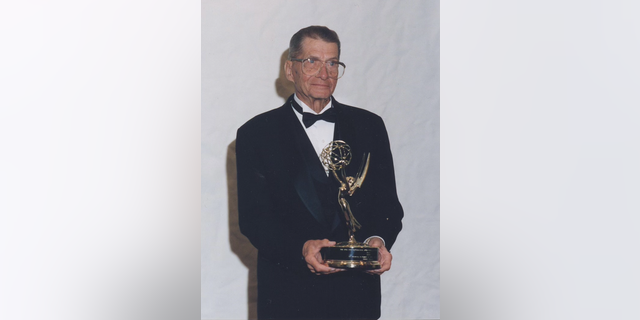
Eugen Polley won an Emmy Award for inventing the TV remote control. He shared the honor with fellow Zenith engineer Robert Adler, who made advances on Polley’s original work.
(Courtesy Gene Polley Jr.)
Commander McDonald gave him a $1,000 bonus in recognition of the technological breakthrough in remote technology.
CLICK HERE TO SIGN UP FOR OUR LIFESTYLE NEWSLETTER
He had lived long enough to receive the acclaim due to him for his innovation; he had lived long enough to see a world in which the remote-control technology he pioneered was so ubiquitous we can’t image life without it.
Polley and Adler were the subject of a glowing tribute in Sports Illustrated in 1999, which honored them as the magazine’s “Men of the Millennium.”
Author Steve Rushin made a special effort to single out Polley for his achievement.
CLICK HERE TO GET THE FOX NEWS APP
“Yes, society has circled back to Polley’s original concept,” Rushin wrote, noting the technological return to light-powered remote control.
“This flippin’ genius now has a glorious 75-button remote in his home. An emperor in his easy chair, Polley … sometimes wears one of those novelty caps sold at truck stops. The cap’s foam crown declares him, now and forever, King of the Remote Control.”
To read more stories in this unique “Meet the American Who…” series from Fox News Digital, click here.